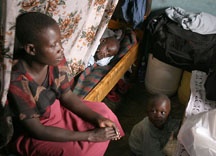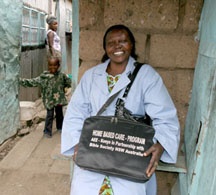Over one and half million people live in the slums of Nairobi, Kenya. That is half the city’s population. More than 300,000 people are crowded together in Karagoche, Nairobi’s worst slum. Families live in extreme poverty and struggle to make a living. People are selling things at every corner: small bundles of firewood, tins of charcoal, clothing, cobs of maize cooked over a charcoal fire, kitchen utensils, packets of food and fruit. In fact, it’s been said that you can get almost anything in the slums of Nairobi.

A young mother and her two children all
suffer from AIDS. |
The seven slum areas are spread across the northern and western sides of the city and in many cases are adjacent to some of the wealthiest residential and business districts. The Kibera slum is literally a stone’s throw from the presidential palace. The palace wall, topped with electrified barbed wire, actually forms one boundary of the slum. That poverty can exist so close to power and wealth is the disparity that is Africa.
When a person goes to Nairobi, there is immediate sensory overload. There are so many people. There is so much noise. There is so much activity. And there are smells of all sorts: cooked meat or chips, burning wood and open drains and sewers. There are children everywhere inquisitively asking, “How are you?” Many smile and delight in having their photograph taken. Despite the poverty, they’re all dressed remarkably well with bright reds and blues set off against their dark skin.
There are signs attached to every building that extol the virtues of the services offered by the shop or owner. The irony is that many will never be able to fulfill these services. There are also signs for churches. There are traditional churches such as Anglican, Baptist and Presbyterian, but there are also churches with names such as Redeemed Gospel Church, Victory World Outreach, Eternity Worship Church and Glory Worship Center.
Amidst all this are the workers from the African Enterprises’ (AE) HIV/AIDS Home Based Care (HBC) program, funded by Bible Society NSW donors. Each worker wears a blue coat and carries a shoulder bag with writing that tells others they are part of the HBC project. Without these coats, the women volunteering might be perceived as prostitutes.

An HBC worker.
|
Each day over 120 HBC workers visit HIV/AIDS patients in the slums. In most cases, these patients have been deserted by family and friends and are living in extreme poverty. Chris Melville from Bible Society NSW, Meretab Teki from AE’s Sydney office and I were invited to tag along with the HBC workers as they visited patients.
Chris and I were apprehensive to say the least and definitely out of our comfort zone. Because I love filming my surroundings, I was consoled by the fact that I had a backpack of video and still camera equipment. Filming and shooting stills in such an environment was going to be a challenge but the filming gave me something other than my surroundings to focus on.
Our visit had been well-organized. If we had not had local community leaders with us, it would have been quite dangerous to walk the streets as we did. Of course, our being Caucasian didn’t help. Beth, a trained nurse who runs the HBC project, led us through streets that quickly became lanes and then narrow alleys. As we approached the rooms where each patient lived, the path deteriorated to a narrow track hemmed in by walls and roofs of other huts and structures. Using the word “home” to describe these dwellings would not make sense to westerners; however, for the millions who live in these conditions, it is home.
The HBC workers are often the only visitors AIDS patients receive. The stigma of their condition has caused them to be deserted by family and friends.
Following Beth and the workers into the homes was a challenge. The patients knew we were coming. Although they were grateful for how the project had helped them thus far, entering someone’s home, knowing the person was terminal and knowing I had to film the visit, brought many questions to mind:
- Was it ethical to take pictures and video footage of patients who were in the terminal stages of their illness?
- Were we invading their privacy?
- What right did we have to show these images at a dinner function back in Australia, where the money we spent eating and socializing could make a major difference to how these people lived?
There was also the question of how would I cope with taking such images. What right did I have to exploit their condition in order to get some “great shots”?
Even now, I am not sure I can answer my own questions. On one side there is the reality of fundraising in Australia. People give more if they can “see” where their money is going and this is often done through still and video footage. But should this be the way funds are raised? Why do we need to see images and footage of people suffering from AIDS halfway around the world in order to be motivated to give?
These questions soon got pushed to the back of my mind as I focused on the technical side of shooting under cramped and difficult conditions. Filming the care HBC workers gave to each patient was inspiring. As they washed them and massaged the joints of the many AIDS patients, we could see the love these workers had for these people. This was not just a job. It was something they did out of Christian compassion.
What impacted me most in Nairobi was the generosity of the people. They did not have anything material to give; however, each gave of themselves by allowing me to capture images of where they lived and how the disease had changed their lives. Through me, they wanted to thank those who had made the daily visits of the HBC workers possible. It was a humbling responsibility.
If I do go back to Kenya within the next year, I will meet up with Beth and her team of workers. However, there will be many people I met on this last trip who will have died from AIDS. I hold on to the hope that through this project some will have heard about the love of God and will have made a decision to commit their life to him. I think that makes it all worthwhile. Don’t you?

